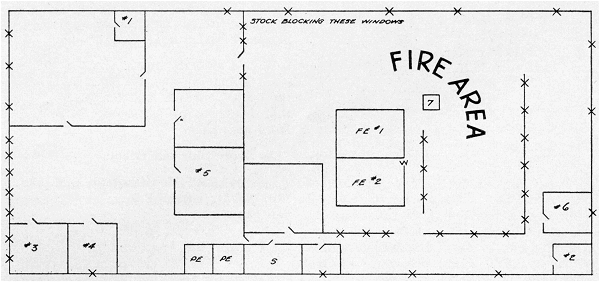|
Fighting a High One Ninth Floor Blaze
With A T 11:50 p.m., on March 4, 1944, Engine Companies 29, 32, 35, Truck Company 29, and Salvage Company 32 responded to a fire on the ninth floor of the American Storage building at 3636 Beverly boulevard. There was no wind. It had been raining. This 13-story, Type I building, with the exception of the ninth floor, has been taken over by the Army Air Forces. The ninth floor is occupied by J. F. Gorman, who manufactures vitamin pills. Upon arrival of the battalion chief, Captain Hubert W. Johnson, Engine 32, reported that the fire floor was too hot and smoky to permit entrance to the floors from the passenger elevator shaft. Orders were given to lay lines onto the standpipes in the two fire escapes and smoke towers. The officer in charge proceeded to the eighth floor via the passenger elevator and then by means of the open air stairway to the ninth floor. The floor was surcharged with heat, and smoke to a degree that would not permit entrance. Captain Pope, Truck 29, ventilated this floor with a ball and chain by operating from the eleventh floor as the windows on the tenth floor were inaccessible. The concrete slab over the freight elevator shaft was lifted as high as possible. Truckmen cut a hole through each of the fire doors from the two fire escapes and smoke towers in order to pull the draw bolts and open the doors by turning the knobs from the inside. As the prevailing wind (there was none) is from the southwest, the door from the northwest smoke tower (No. 2) was first opened so the men could go in with less punishment. However, men wearing Burrells could not get in far enough to see the fire on account of the heat and the gummy deposit on their eyeglasses that prevented them from seeing. The diagram shows how the partitions blocked the visibility of the fire and also prevented ventilation. Gibbs were tired, but were a failure on account of the heat. When the fire door from the southeast smoke tower (No. 1) was opened, entrance could not be made for the same reason.  1 and 2, fire escape and smoke towers; 3, 4, 5 and 6, glassed partitioned rooms; PE, passenger elevators; FE, freight elevators; S, outside stairway, no standpipe; 7, icebox, approximately 8x8 feet; partitions to or almost to ceiling are marked with x; W, window in freight elevator shaft door; X, windows. |
|
|
Captain John W. Miller, Engine 29, the narrator, and the employee went up the freight elevator to the ninth floor and sized up the fire through the wired glass window in the freight elevator door. On the way down to the eighth floor, the elevator was stopped between floors to see whether there was sufficient clearance between the elevator and the elevator shaft for 1 1/2-inch hose. One and one-half inch hose was connected to the interior standpipe on the eighth floor. About two-thirds of a section was placed into the freight elevator. Captain Miller, two of his company, and the narrator, and the elevator operator proceeded to the ninth floor, the plan being to break out the wired glass window in the freight elevator door and cool off the fire before opening the doors. As soon as the elevator stopped, the elevator operator pulled the strap that opened the doors. The firemen immediately assumed a kneeling position and started the water. The doors, when opened, allowed the heat to roll into the elevator. The elevator operator, who was standing upright, became frightened; thought he was going to be burned alive and die; started to pray. With the physical assistance of Captain Miller, the elevator operator lay prone on the elevator floor with his nose in the fresh air in the elevator shaft, continuing his supplications. Moral: "Never place dependence upon a civilian." This line worked out from freight elevator shaft (No. 2) nearly to the ice box (No. 7), but could go no further on account of the fumes from the ice box. The partition opposite the freight elevator door was knocked over and the fire behind it killed. Shortly thereafter the line from smoke tower No. 1 moved to the freight elevator. When Assistant Chief George J. Davlin arrived and received a report as to what action had been taken and what was needed, he called for Salvage Company 27 and two Gibbs breathing apparatus. As the water was beginning to flow down the freight elevator shaft, Engine 32 began to do salvage work. Sawdust was banked in an arc about 6 to 8 feet out from the freight elevator doors on the floors below to prevent water from flowing out on the floors. The eighth floor was covered; the floors below continuously checked for water coming through the floors. Later, an ejector was placed in the bottom of the freight elevator shaft and operated as needed. In the meantime, as some of the heat had escaped or been absorbed by the water, men with Gibbs and without Gibbs took the line from the southeast smoke tower (No. 1), worked their way through the cascaded piles of stock and extinguished the fire on the south side of the freight elevator shaft. The interesting features of this fire were:
All members who responded to
this fire received considerable punishment from the fumes and smoke which
affected their eyes. On account of their dogged determination to get at
the heart of the fire and their spirit of trying to bore in to do their job, the
members of the department working at this fire had to take excessive punishment.
April, 1944 The Firemen's Grape Vine |
This article appeared in the April 1944 issue of THE FIREMEN'S GRAPE VINE.
LAFIRE.COM
Copyright 2000 All Rights Reserved.